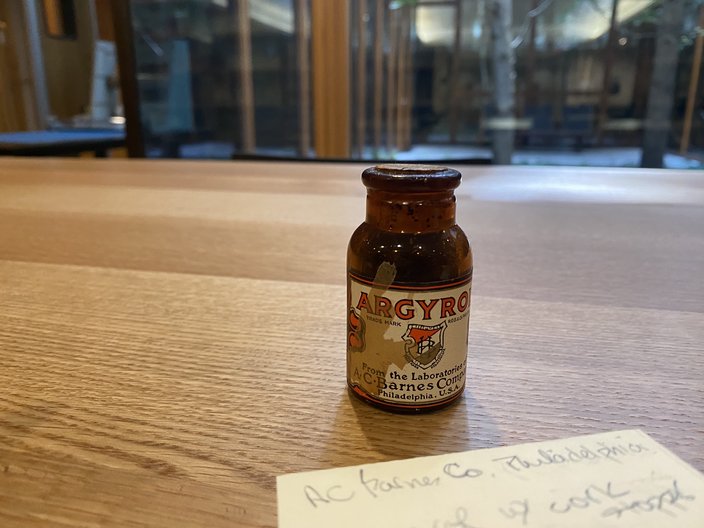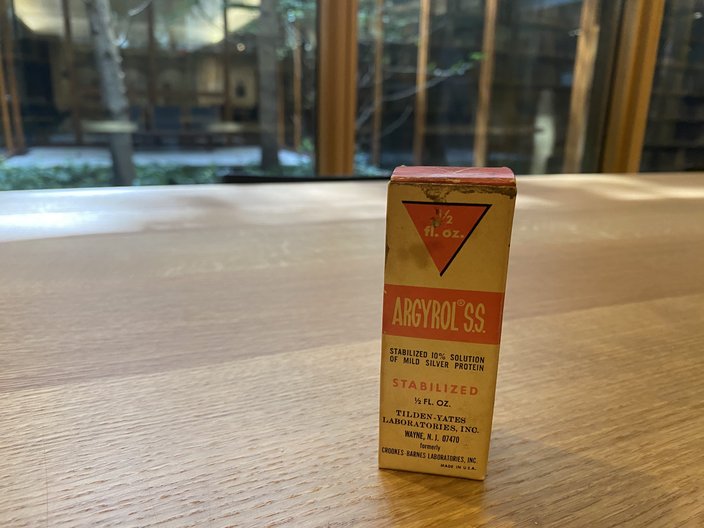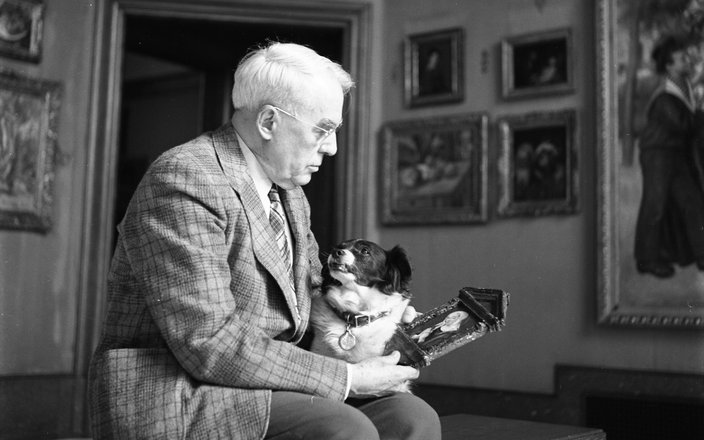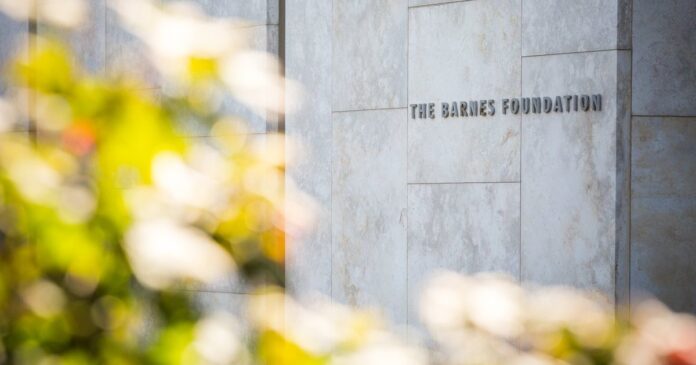The renowned collection of Renoir, Cézanne and Picasso paintings at the Barnes Foundation was built on a silver protein solution, packaged in a tiny glass bottle and used to protect newborn infants from blindness brought on by a sexually transmitted disease.
- INSIDE THE ARCHIVES
- PhillyVoice peeks into the collections at different museums in the city, highlighting unique and significant items you won’t typically find on display.
Dr. Albert C. Barnes, the founder and namesake of the foundation, made his fortune on argyrol, a formulation he invented with the German chemist Hermann Hille. The pair developed the medicine at the dawn of the 20th century, years before antibiotics or any effective treatment for gonorrhea, which mothers could unknowingly pass onto their babies. Exposed infants often developed ophthalmia neonatorum, an eye infection that can cause ocular scarring, perforation or blindness as quickly as 24 hours after birth. Before doctors had the right eye drops to administer, up to 79% of children in schools for the blind had a history of gonococcal ophthalmia neonatorum.
Several antique bottles of argyrol now rest in the archives of the Barnes Foundation, a reminder of the scientific origins of one of the city’s greatest art collections.

 Kristin Hunt/PhillyVoice
Kristin Hunt/PhillyVoice
A glass bottle of argyrol with a cork stopper manufactured by the A.C. Barnes Company in Philadelphia.
Like his foundation, Barnes was a Philadelphia institution. The future doctor and art collector was born in Kensington in 1872 and grew up in the section of South Philly that’s now the Stadium District. Back then it was The Neck, an area known for its marshlands, pig farms and mountains of trash. The Barnes family didn’t have a lot of money, which meant Albert put himself through medical school at the University of Pennsylvania after graduating from Central High School. He funded his tuition through boxing and a series of side hustles.
Practicing medicine ultimately didn’t interest Barnes. After working for a year at a mental institution, he traveled abroad to Germany to study chemistry. There he became acquainted with Hille. Their eventual argyrol solution built on existing silver protein solutions, but crucially, it was easier on newborns’ sensitive eyes. It was the most lucrative invention for the partners — who also developed Ovoferrin, an iron supplement used to treat anemia — though they parted ways in 1907 over a clash of personalities.
“Barnes really had a hard time with a lot of people,” Amanda McKnight, director of archives at the Barnes Foundation, said. “We see this over and over again in the course of his relationships. He’s very close to a person, they get along for years and years and years, and then he kind of just cuts them off. He was very stubborn, very set in his ways.”
After he cut ties with Hille, Barnes continued to manufacture argyrol under his newly formed venture the A.C. Barnes Company. With a steady influx of cash now coming his way, Barnes picked up a classic rich person hobby: art collecting. He turned to William Glackens, an artist and one of his former classmates at Central, for help procuring new pieces. Barnes sent Glackens, whom he nicknamed “Butts” for the shiny buttons on his coat, abroad in 1912 with $20,000 to spend on art. When Glackens returned from Paris with original paintings van Gogh and Renoir, McKnight said, Barnes realized how “basic” the Barbizon school landscapes adorning his home were. He quickly developed a taste for modern European art.

 Kristin Hunt/PhillyVoice
Kristin Hunt/PhillyVoice
Argyrol was given to newborns to prevent eye infections caused by a gonorrhea, which could be unknowingly passed to babies from their mothers and untreated could cause blindness.
Barnes landed on the idea for his foundation — which he conceived as an educational institution, not a museum — after leading seminars at his pharmaceutical factory at 40th and Filbert streets. Its staff was small but wildly efficient, leaving extra time for conversation, though it wasn’t typical water cooler talk.
“They worked as a collective, so they were able to get an eight-hour day done in six hours,” McKnight explained. “And so they used two hours of the day for study and seminars and they would read. If you couldn’t read, someone would read to you. Everybody participated.”
While these study sessions were initially focused on philosophy, drawing on the works of Bertrand Russell and William James. After the group read the Spanish thinker George Santayana’s 1896 treatise on beauty, Barnes brought in some of his art to augment the discussion. Art, he realized, was a vital teaching tool. He began teaching classes, often soundtracked with playlists of his favorite classical music on Magnavox, at various institutions while architect Paul Phillippe Cret designed a new gallery space for him on a 12-acre arboretum in Merion. The classes continued in this Beaux-Arts mansion, the original location of the Barnes Foundation, when it opened in 1925.
Barnes was very particular about his foundation and collection. Though anyone attending a class at the Merion center would see his priceless paintings, there were no visiting hours at the Barnes Foundation. Art enthusiasts had to personally request permission to visit, and Barnes had some eccentric ways of saying no. He rejected Alexander Woollcott, a member of the famed Algonquin Round Table, with a letter he signed with his dog Fidèle’s name. Made-up secretaries shut out other luminaries, insisting that Dr. Barnes was simply too busy swallowing goldfish.

 Angelo Pinto/Photograph Collection, Barnes Foundation Archives
Angelo Pinto/Photograph Collection, Barnes Foundation Archives
Dr. Barnes sits with his dog Fidèle in one of the foundation’s galleries.
“He (had) a huge chip on his shoulder for people who were entitled,” McKnight said. “And so he would send back outlandish telegrams, letters for people he thought were being a little too, like expecting to come and see something.”
After Barnes died in a 1951 car accident, these restrictions gradually loosened. The public was allowed to visit, no appointment necessary, starting in 1961. The collection then moved from its Merion home, amid considerable controversy, to a much sleeker building in Logan Square in 2012. Just last year, the foundation began loaning paintings from its collection to museums and other institutes.
But Barnes’ precise and arguably peculiar vision is still alive in the unique way the art is displayed in “ensembles” with metalwork and furniture. (“The artwork is hung according to the ideas of looking at art through light, line, color and space,” McKnight added.) Though visitors can now access a digital guide on their smartphones, there are no plaques offering context or even titles for the various masterpieces that crowd the walls. And educational programs remain a focus, from the foundation’s ongoing work with formerly incarcerated artists to its Art, Well-Being, and Medicine workshops for medical students and health care professionals. The latter, another thread connecting Barnes’ passion for science with painting, encourages a “more empathetic and humanistic approach to patient care.”
“In Barnes’s time, he was very much focused on … these formal views of art,” Deirdre Maher, director of communications for the Barnes Foundation, said. “So looking at light, line, color and space. Our education program now moves beyond just a formalist approach to art and really looks at what was happening in the social and political and cultural context.
“Education is still at the heart of everything we do, but it’s definitely expanded.”
Follow Kristin & PhillyVoice on Twitter: @kristin_hunt
| @thePhillyVoice
Like us on Facebook: PhillyVoice
Have a news tip? Let us know.



